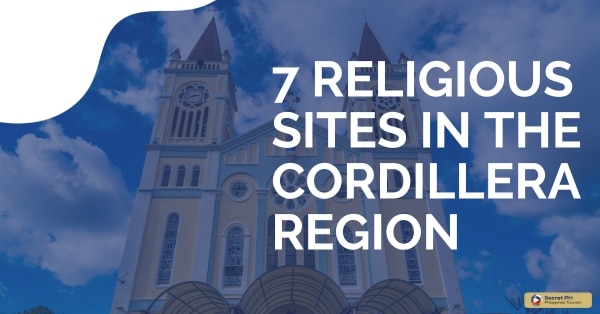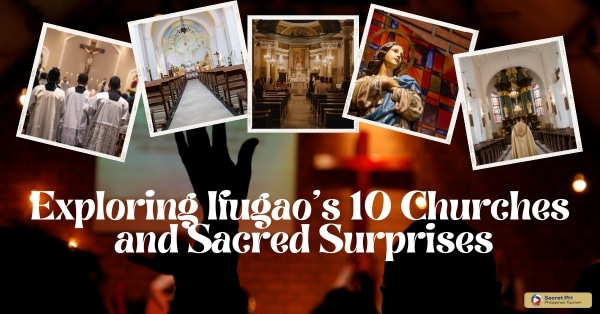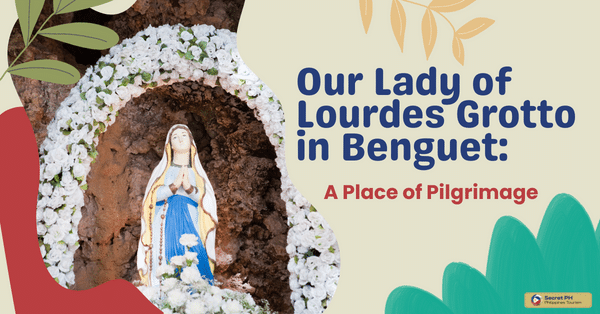Visiting the Philippines can be quite a unique experience as there are many different religious customs and traditions that you should be aware of, especially if you want to make a good impression. Covering topics such as what clothing to wear, language etiquette and gestures, this blog provides 10 tips that are essential for showing respect when visiting the Philippines and learning more about their culture.
From avoiding making jokes about religion to giving respectful salutations, these tips will help you feel confident in knowing that you’re being respectful during your stay. Ready to learn more? Read on for an in-depth look at all the ways that visitors can show respect for religious customs and traditions in the Philippines.
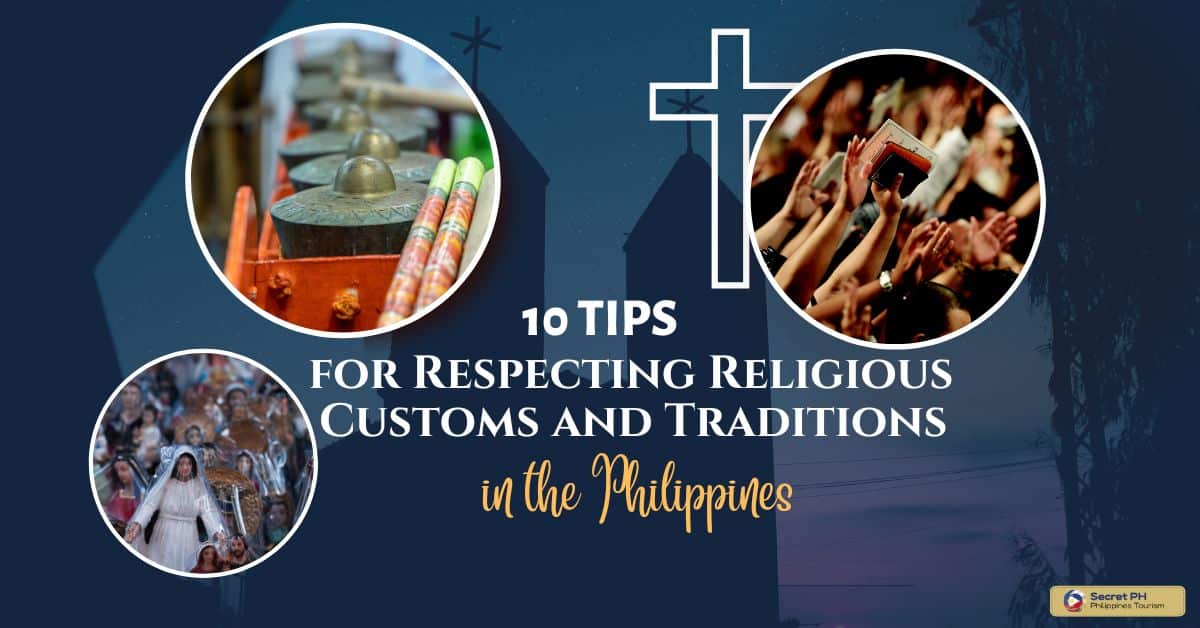
Importance of Respecting Religious Customs and Traditions in the Philippines
Respect for religious customs and traditions is essential in the Philippines. Religion plays an important role in Filipino culture; it shapes the nation’s social and cultural identity and contributes to the country’s vision for a harmonious society. Respect for the beliefs and practices of Filipinos is mandatory, as it affects social order and strengthens relationships between different socio-economic groups.
It is important to acknowledge that although other religions may differ from one another, it is necessary to accept them and celebrate our diversity. Respect for religious customs and traditions also brings a sense of comfort, security, and acceptance within communities; it enables us to be open-minded about our own values as well as those of others. By respecting each other’s beliefs, we reinforce our commitment to peace, unity, and communal harmony which helps the nation develop further.
Understanding the Context
Understanding the context behind the importance of respecting religious customs and traditions in the Philippines is essential. As a nation, they are largely influenced by their religion and religious practices. Philippine’s history holds a close connection to spiritual belief systems as well as precious cultural gems that often go hand in hand with faith.
Most Philippine traditions and customs have incorporated various aspects of their predominant religions, bringing them closer to their beliefs while becoming more influential in everyday life. Understanding and respecting these customs not only enables us to gain a greater understanding of when travelling or doing business in the Philippines but also pays respect to the citizens who value them dearly.
Explanation of the history and cultural context of the Philippines
Understanding the cultural and historical context of the Philippines helps us to appreciate how far they have come. With origins dating back more than 30,000 years ago and numerous cultural influences, the Philippines has created a unique identity that continues to capture the attention of people around the world.
Over its long history, the country has been subject to colonization by countries such as Spain, United States and Japan and has also seen numerous changes in political regime right up until today.
- The Philippines has a rich history influenced by various cultures, including indigenous, Malay, Chinese, and Spanish.
- The Philippines was a Spanish colony for 333 years, leaving a significant impact on culture and language.
- The Philippines is made up of over 7,640 islands with different indigenous tribes and languages
- The Philippines is predominantly Catholic due to Spanish colonization.
- The Philippines has a strong tradition of oral storytelling, music, and dance.
- The Philippines has a diverse cuisine influenced by Malay, Chinese, Spanish, and American cultures.
- The Philippines has a history of resistance and rebellion against colonial powers.
- The Philippines was occupied by Japan during World War II.
- The Philippines is known for its natural beauty, including beaches, mountains, and rice terraces.
- The Philippines has a vibrant festivals and customs throughout the year.
Explanation of the role of religion in the Philippines
Around 91 percent of Filipinos are affiliated with some religious denomination, and of them approximately 80 percent are Christian, primarily Catholic or Protestant denominations. The remaining 11 percent consist mostly of Muslim denominations, collectively known as Islam. It is important to note that the nation also possesses a strong animistic tradition where some individuals may believe in both spiritual and non-spiritual beliefs at once.
- Religion plays a significant role in the daily lives of many Filipinos.
- The Philippines is predominantly Catholic, with a significant minority of Muslims and other religions.
- Religion is deeply intertwined with culture and tradition in the Philippines.
- Many religious holidays and celebrations are an important part of Filipino culture.
- Religion serves as a source of community and social support for many Filipinos.
- Religious beliefs and practices are often integrated into daily life, such as in the practice of “panat” or offering.
- Many Filipinos turn to religion for guidance and support in difficult times.
- Religion is often used as a source of inspiration for art and literature in the Philippines.
- The Catholic Church has played an important role in the Philippines’ political history.
- Religion remains an important and influential aspect of Philippine society today.
Explanation of the relationship between religion and culture in the Philippines
For centuries, spiritual beliefs have shaped Filipino culture and everyday life. While Christianity is the dominant religion, there is still a vibrant belief system that includes animism, Hinduism, and Buddhism. These are interwoven with traditional Filipino customs such as ancestor worship, festivals honoring saints and local deities, superstitions about health and luck, and annual parades in honor of patron saints.
- Religion and culture are deeply interconnected in the Philippines.
- Many Filipino customs and traditions have religious roots and significance.
- Religion is often intertwined with daily life and cultural celebrations.
- Religion and culture influence each other in shaping the Filipino identity.
- Cultural practices like music, dance, and festivals often have religious themes or significance.
- Many traditional Filipino beliefs and practices are influenced by both indigenous and religious beliefs.
- Religion is an important part of Filipino heritage and cultural identity.
- The Catholic Church has played an important role in preserving and promoting Filipino culture.
- The relationship between religion and culture is complex and varied in the Philippines.
- Religion and culture continue to evolve and interact in contemporary Philippine society.
10 Tips for Respecting Religious Customs and Traditions in the Philippines
Whether you are a fellow Filipino or even a foreigner, it is important to understand the religious customs to maintain harmony with locals. Taking into account the traditional social norms around religion will help ensure respectful communication and interaction with Philippine people.
It’s true that by taking these precautions, foreigners may be limiting themselves from certain activities out of respect. Nonetheless, by following these 10 tips for respecting religious customs and traditions in the Philippines, efficient relationships can be established between all types of individuals.
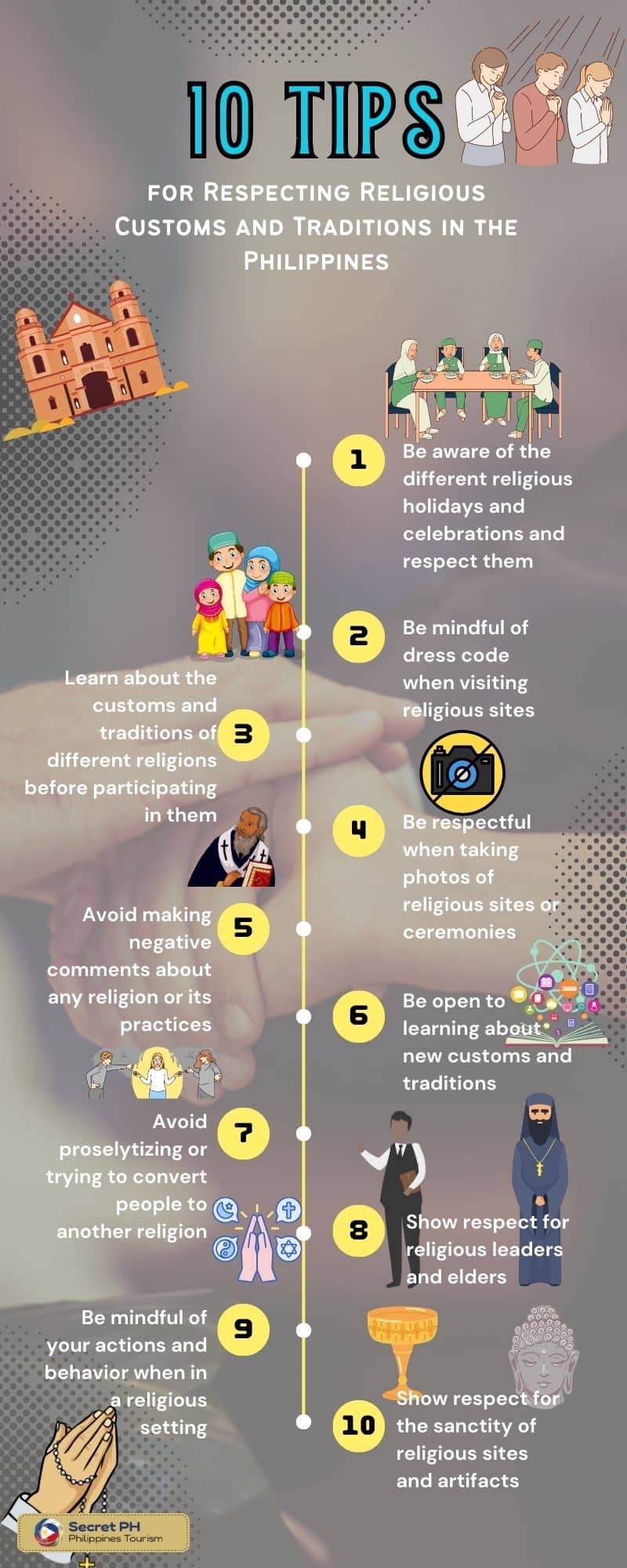
Tip 1: Be aware of the different religious holidays and celebrations and respect them
Respecting religious customs and traditions in the Philippines is vital to successful interactions with people of different cultures. It demonstrates an appreciation for the customs, values and practices that are deeply-rooted in many of these societies and facilitates better communication between people.
Awareness of religious holidays and celebrations helps create positive relationships with members of Philippine society from a variety of cultural backgrounds. Being familiar with the important dates in each creed can also increase respect for those groups and lead to stronger relationships.
Tip 2: Be mindful of dress code when visiting religious sites
While each religious group may vary in terms of their expectations of what visitors need to wear, it’s respectful to cover shoulders and knees while visiting any place of worship. Additionally, avoiding bright colors or flashy accessories is usually considered polite. Also, it’s best to avoid wearing long clothing like capes or robes as they may be mistaken for traditional garments worn by clergy members or other honored person within that faith.
Tip 3: Learn about the customs and traditions of different religions before participating in them
It is essential to learn about different religions and become aware of their customs and traditions before participating in them, so that we can show proper respect and honor other cultures. Oftentimes we may find ourselves taking part in religious ceremonies without understanding their significance, which can be deeply disrespectful.
By familiarizing ourselves with each religion’s practices and expectations, we are better equipped to not only understand our own beliefs, but also the views of those different from us. All this is invaluable when it comes to building strong relationships with those around us and demonstrating our appreciation for cultural diversity.
Tip 4: Be respectful when taking photos of religious sites or ceremonies
People should always strive to be respectful when taking photos of religious sites or ceremonies in order to show courtesy and appreciation for the culture. This means no posing, loud conversations, or laughing as it could be seen as disrespectful.
Additionally, it is important to ask permission before taking a photo and wait for a response before attempting to do so. Many cultures require people to remove their hats or cover the arms and legs when visiting a place of worship, allowing those wishing to take photos to follow those same customs properly.
Tip 5: Avoid making negative comments about any religion or its practices
It is essential to show reverence and respect for all religions, so when discussing them, one should abstain from making negative comments. Respecting one’s faith can also have positive impacts on developing relationships with individuals from other religious backgrounds.
The fundamental core of mutual respect helps create a much more peaceable environment that encourages positive interactions with everyone regardless of their beliefs. It is best to practice respect by avoiding speaking poorly or negatively about any religion or its practices.
Tip 6: Be open to learning about new customs and traditions
Respecting the customs and traditions of other cultures is important for developing meaningful relationships. In particular, learning about those from the Philippines can provide us with an enriched perspective that can help us better understand their values.
From religious rituals like praying five times a day to festivals such as Bulul that are celebrated around their harvest season, exploring these customs helps facilitate understanding and mutual respect. Being open to learning about new beliefs and way of life not only reflects a deep appreciation for diverse cultures, but also serves as an exemplary foundation to grow upon.
Tip 7: Avoid proselytizing or trying to convert people to another religion
In order to ensure harmony among its diverse beliefs, it’s important to avoid proselytizing or trying to convert people from one religion to another. Not only does such action perpetuate a spirit of competition between different denominations, but it can also cause undue stress on the individual being approached by their views and ideals for their religious beliefs.
In order for all residents of the Philippines to get along, respect for varying belief systems is a must. Respecting each other’s religious convictions and avoiding proselytizing are important steps towards harmony.
Tip 8: Show respect for religious leaders and elders
Showing respect for religious elders not only honors them but reflects positively on the state of the community. Respected elders are generally highly regarded, and being seen as respectful to them can carry a great deal of prestige in a society. Furthermore, showing respect for religious leaders and elders also reinforces social divisions that help a group form its own identity and values.
People who show reverence for those who have come before build cohesion among individuals, making them feel more connected with each other despite differences in beliefs or backgrounds. Respecting religious customs and elders is key to maintaining harmony within communities.
Tip 9: Be mindful of your actions and behavior when in a religious setting
When present in a religious setting, it is important to practice mindfulness and respect. Respecting religious customs holds true everywhere but is especially paramount in the Philippines, where deep-rooted traditions are integral to its culture.
Respect for elders, expressing humility, avoiding loud laughter and frivolous talk, covering one’s head when entering places of worship – these are some of the simpler courtesies that should be taken into account when visiting a place of religious significance. It is also best to engage in appropriate conversations with locals as people from different faiths come together in sacred spaces. Respecting religion can promote positive values such as patience and courtesy between people from all walks of life.
Tip 10: Show respect for the sanctity of religious sites and artifacts
Respecting the sanctity of religious sites and artifacts should be a priority for all of us, especially in the Philippines. As the country is home to numerous faiths that co-exist peacefully and harmoniously, it is important to respect and honor shared beliefs by respecting their customs and traditions. Every year millions of people from different religions visit many pilgrimage sites to pay homage, pray or just to appreciate the beauty of cultural heritage.
However, care must be taken not to tamper with any artifacts associated with these revered places or act in ways that are incompatible with their underlying faith culture; such as taking selfies next to shrines or monuments dedicated as memorials. By showing respect for each other’s beliefs, we can ensure the safekeeping of our nation’s rich religious heritage.
In Conclusion
Respecting religious customs and traditions in the Philippines is highly important for visitors to be aware of in order to avoid offending local people. Practices such as avoiding public displays of affection, photographing sacred sites, avoiding discussion of political or religious topics, and being mindful of footwear while entering places or worship are just a few of the 10 Tips for Respecting Religious Customs and traditions in the Philippines.
As a general rule of thumb, if someone asks you to do something regarding religious customs, it is best to obey their requests out of respect. Ignoring these practices can be seen as an insult by locals who have great respect for their culture. By learning about and respecting local customs and beliefs, travelers can ensure they receive a warm welcome when visiting the Philippines.


